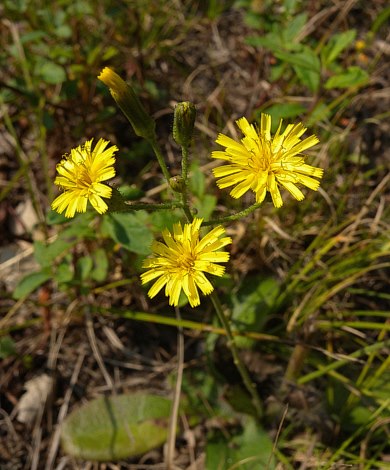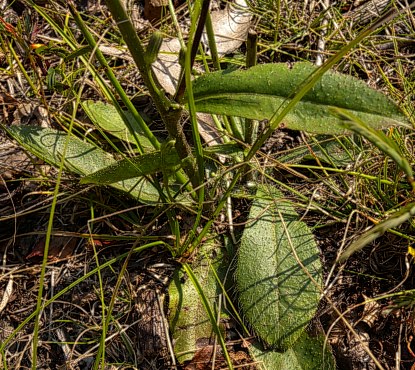Description: This perennial herbaceous plant is 1-3' tall, consisting of a rosette of leaves from which a flowering stalk develops. The basal leaves are up to 6" long and 2" across, tapering to a narrow petiole. They are ovate or oblanceolate, usually with smooth margins, and have scattered white hairs that are ½" or less. The flowering stalk is variably hairy, with a few small leaves alternating along the lower half. The upper half of the stalk is either leafless, or has a few tiny leaves that resemble bracts. Generally, the lower stalk is conspicuously hairy (particularly near the bases of the leaves), while the upper stalk has few or no hairs, except where the flowers occur. This stalk terminates in a panicle of composite flowers. Each composite flower is about ½–¾" across, consisting of a head with 15-30 yellow ray florets. The ray florets have tips that are truncated, ending in 5 small teeth. The blooming period is mid-summer to early fall, and lasts about 1-2 months. Beneath the ray florets, there is a cylindrical arrangement of narrow bracts. These bracts are green or purplish green. The slender stems within the panicle have glandular hairs that are ½" or less; like the bracts, these stems are green or purplish green. The florets are eventually replaced by achenes with white or brown tufts of hair. These achenes are spindle-shaped, tapering at both ends; they are dispersed by the wind. The root system consists of a short crown with fibrous roots underneath; sometimes rhizomes are produced, enabling vegetative reproduction.

Cultivation:
The
preference is full sun to light shade, and moist to slightly dry
conditions. Gronovius' Hawkweed normally grows in soil that is sandy or
rocky, which reduces competition from other plants. The height of this
species is variable, depending on such factors as light and moisture
levels.
Range & Habitat:
The native Gronovius' Hawkweed is scattered throughout Illinois, except
for many
counties in the NW and central areas of the state (see Distribution
Map). Depending on the area, it is occasional to rare or
absent. Habitats include moist to mesic sand prairies, sandy thickets,
openings in rocky or sandy woodlands, savannas, bluffs, and edges of
fields. Where this plant grows in shade, it is usually taller and grows
in drier locations. Where it is sunny, this plant is usually shorter
and prefers moister locations.
Faunal Associations:
The nectar or pollen of the flowers probably attracts many kinds of
insects, including long-tongued bees, short-tongued bees, bee flies,
and beetles. The seedheads are eaten by the Wild Turkey, while the
foliage is eaten by mammalian herbivores, including deer and rabbits.

Photographic
Location:
Along a sandy path in a Black Oak savanna at Hooper Branch Savanna
Nature Preserve in Iroquois County, Illinois.
Comments:
Another common name for this species is Hairy Hawkweed, although this
name is also used for Hieracium longipilum. The Hieracium
spp. are another group of plants that can be tricky to
identify. They fall into two broad groups: short stoloniferous plants
that consist of leafy rosettes, and taller plants with a flowering
stalk that is more or less leafy. The former group is dominated by
introduced species from Europe, while the latter group consists of
native species. Gronovius' Hawkweed is similar in appearance to Hieracium
longipilum (Hairy Hawkweed) and Hieracium scabrum
(Rough Hawkweed). It differs from the former by having fewer and
shorter hairs of ½" or less, and differs from the latter by the absence
of leaves on the upper flowering stalk that are any larger than tiny
bracts. Gronovius' Hawkweed has spindle-shaped achenes (tapering on
both ends), while Rough Hawkweed has bullet-shaped achenes that taper
only at the bottom. Other native Hieracium spp.
have hairless foliage and stalks, conspicuous teeth along the margins
of the leaves, or flowers that are 1" across or more.